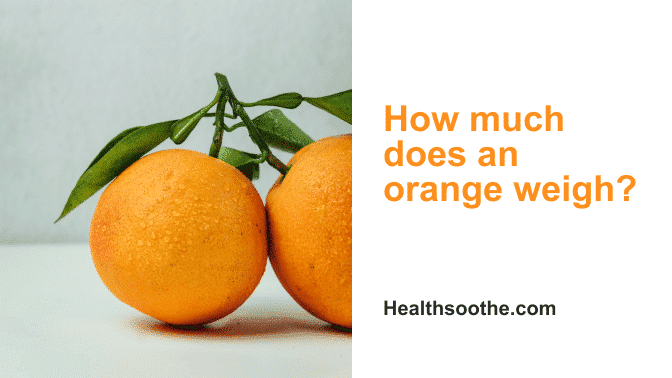Oranges are a great source of vitamins and minerals, with vitamin C being the most prevalent and essential for healthy growth and development.
Additionally, it aids in the body's tissue repair, and vitamin C's antioxidant properties fight free radicals and mitigate some of the damage they can do.
Oranges also include fibre, Vitamin B1, copper, folate, potassium, pantothenic acid, and calcium, in addition to the other nutrients listed above. A person needs vitamin C in their diet since their body cannot manufacture it on its own.
In the western hemisphere, oranges are among the fruits that are most often bought. Finding the average weight of oranges is a useful idea in order to avoid spending more money than necessary since, like other organic products, oranges are sometimes priced depending on their weight rather than on a piece-by-piece basis.
Like many fruits and vegetables, oranges are mostly made up of water, which is why they weigh so much. Orange weight is a great indicator of whether an orange is still at its finest quality since oranges start to get lighter as they age or otherwise experience the effects of dehydration.
Oranges typically weigh 4.6 ounces, however, this may vary greatly depending on the species, how old they are, what kind of storage conditions they were kept in, and of course what size they are. An orange typically weighs between 2 and 10 ounces.
What Is an Orange Made of?
Oranges have a lot of water inside of them, just like all organic life forms do, to support their cells.
The U.S. Department of Agriculture's research study found that oranges typically contain 87% water or 86.8 grammes per 100 grammes of the raw orange product.
It is improbable that anybody could imagine realising how little an orange weighs after drying at such a high percentage.
Similar study findings published by the USDA indicate that the remaining majority of an orange's chemical compounds are mostly carbs, with 9.35% being sugar and 2.4% consisting of different kinds of fibre.
Based on this, it may be inferred that oranges have just 47 kilocalories on average per 100 grammes consumed, however, this number is probably lower since most people do not eat the orange peel, which contains the bulk of the fruit's fibre.
Are All Orange Species the Same Weight?
Given that oranges come in many different species with widely varying weights and volumes, it is common practice to factor in the particular orange species when determining the overall weight of oranges that are required.
The Californian Valencia oranges are typically only 121 grammes in weight, which is the same weight as an orange that is considered small by a number of legal definitions. This makes them smaller than the typical commercially available orange.
It is advisable to consider their weight difference from the typical commercial orange when selecting to buy Californian Valencia oranges.
The navel orange, which is on the other end of the weight spectrum, varies slightly from the Californian Valencia orange due to the structure of its peel and average overall size.
Typically, a navel orange will weigh 140g or about the same as a medium-sized commercial orange as specified by law.
The tangerine, often known as the 1mandarin orange, is one of the smallest commercially available species of orange and is far smaller than any of the aforementioned species.
The mandarin orange's weight varies just as much as a typical commercially available orange, but even at its largest, it weighs only about 120 grammes on average, or about the same as a medium-sized standard orange.
It's also crucial to consider the total volume of the flesh in each species because some, like the 2Californian Valencia orange, have thicker and larger peels, which means that a greater proportion of their weight is made up of the inedible outer peel than edible inner flesh.
In addition to individual variations in the component parts, purchasing a single, bigger orange is preferable to purchasing many, smaller ones since there will be less flesh overall to peel.
How Large Can Oranges Grow?
Since oranges are cultivated in warm, humid settings similar to those seen in certain tropical nations, it is common for them to grow to notable proportions when adequate sunshine and water are available.
The standard commercial orange is clearly defined as belonging to the large category once it weighs 184 grammes or more.
Extrapolating from the U.S. Department of Agriculture's research experiment mentioned earlier, this would roughly equate to 160.08 grammes of the weight of the large orange being made up of water.
With this knowledge, it is also possible to calculate that 184 grammes of a large orange would roughly equal 100 kilocalories or the same number of calories as an apple or two kiwi fruits. Due to this, oranges make a great diet snack that can be included in any diet, regardless of its scope.
What Fruit has a Similar Weight to Oranges?
There are several fruits with about equal weights that may serve as references due to the unique components that go into making oranges. However, these fruits don't contain nearly as much water as oranges do, therefore their nutritional profiles are different.
A medium-sized apple would be the closest weight equivalent to a medium-sized orange. Due to their substantial flesh, apples may weigh almost as much as oranges at their prime.
A single medium-sized banana may be used as a substitute for apples in determining the weight of oranges. This would be equivalent to a regular big-size commercially available orange at 180 grammes per unit of banana.
Read Also: Should I Eat the Peel of an Apple?
Why do Oranges Weigh That Much?
Since oranges are a fruit that is cultivated in tropical areas of the globe, water is easily accessible there in the form of soil moisture as well as humidity in the air. In order to outgrow their non-tropical counterparts, plants make use of this freely accessible resource.
In addition, tropical areas with a lot of plant life often have greater atmospheric CO2 and oxygen concentrations. Most plants use these chemicals to catalyse and speed up their internal cellular processes, with more CO2 and oxygen leading to even faster development.
Conclusion
Depending on size and variation, an orange may weigh anywhere between 2 and 10 ounces with seeds and skin.
The majority of commercially produced oranges are of the standard and navel kinds. I hope this will assist you in finding the information you're searching for.
Additional resources and citations
- 1mandarin orange
- 2Californian Valencia orange



